Around 23,000 people have taken my relationships survey. If you’re in a relationship and haven’t yet, please take it before you read this post and get primed!
Also, my perspective on needing a random sample.
Raw data is here, though unfortunately I had to remove a lot of data to keep it anonymized. If you want more specific subsets I can hand them out upon request.
In my survey, I ask people how monogamous/polyamorous they were. The options were “Fully monogamous”, “mostly monogamous”, “slightly monogamous”, “slightly polyamorous”, “mostly polyamorous”, and “fully polyamorous.” In hindsight I don’t think this was the clearest possible spectrum - for example, it’s not clear what the difference between slightly monogamous and slightly polyamorous is - but I think it’s unlikely that this would result in meaningfully different results than if I’d had a clearer spectrum. Yes, this is ordinal, not sliding, but I don’t see how a sliding scale would fix the problems presented by ordinal options.
I also had a clarification in the question that I’m using the term ‘polyamorous’ to refer to all open relationship types.
I also asked poly people to answer for their primary or longest term partner, and most of the data this article is only measuring these relationships. This means this data does not represent “secondary” or shorter-term partners. I’m going to use the term ‘primary partner’ for ease throughout this article, but I know a lot of people don’t ascribe to primaryship - please don’t take this terminology as me pretending you don’t exist, it’s just for simplicity’s sake!
So - how do people rate their relationships differently based on where on the monogamous-polyamorous spectrum they are?
Before you proceed, try to consciously register some predictions to yourself. In practice, how do you think poly relationships differ? How do you think the kind of people who answer my survey think poly relationships differ? For example:
Do poly people have more or less sex with their primary partner? Maybe poly people are more sexually driven (so more), but maybe when sex is distributed, this reduces total count with primary partners?
Are poly people more or less dependent on each other?
Do poly people have more or fewer kids? Maybe they’re less traditional and thus fewer children, but also maybe more adults around result in greater ease of childcare?
What about fighting? Maybe poly people fight less because they need to have good communication skills in order to be poly, but maybe they fight more because there’s more moving points and thus more drama.
What about relationship length? Maybe poly people have shorter relationships because everything is more unstable, but maybe it’s longer because people don’t have to break up with their partners to pursue others?
I’m about to share a LOT of graphs, and though they’re simple/easy to parse, you can just jump to the end to see my summary/interpretation.
And, outside of practical measures (length, marriage, kids) I’m grouping questions by the way factor analysis grouped them, and naming them with my best squinty guess. I’m not trying to make any point, I’m not claiming my factor analysis was good, it’s just used to categorize/organize the questions here.
I also accidentally switch between two different bin sets for some of the graphs; it was one letter difference in my code, and I goofed. They’re still super similar tho, (e.g., one ends at 22+ year length relationships and the other ends at 21+ years) and it shouldn’t change results much.
Who Took This Survey?
This is a breakdown of demographics to help you interpret the results of this survey with appropriate context. I am not claiming this survey is perfectly representative of the world. I think it is likely that many of the findings would in fact replicate in western culture to varying degrees given a perfectly random sample, but we should be careful to keep in mind ways the sources of the data might be impacting what we see.
I do think this survey is a bit more susceptible to selection bias in the ways I care about compared to other surveys I’ve done, since I am loudly poly/sex positive online, and most of the people who took the survey did know who I was, and I’m looking specifically at polyamory - all these factors are related, and thus a bit concerning. I did not indicate in any way that I would be measuring polyamory in the survey, though, to avoid biasing testtakers. My hope is that this survey can point in some interesting directions - but this, much like all my surveys and all other surveys, even in academia, should not be taken as definitive, unassailable proof of anything.
Source:
Twitter: 51.8%
Other (mostly my friend’s personality testing website): 21.3%
Reddit: 17.7%
Facebook: 3.4%
Fetlife: 2.6%
Telegram: 0.8%
Discord: 0.7%
Sex:
Male: 70%
Female: 30%
Ethnicity:
White: 76.6%
Hispanic/latino: 8%
Asian: 7.1
Other: 4%
Black: 2.4%
Age:
<25 y/o: 26.5%
25-35: 43.4%
35-45: 20.8%
45+: 9.3%
Politics:
(on -3 to 3 spectrum)
Economic liberal : 1.0
Social liberal: 1.8
Gender:
94% cis
6% non-cis
Monog/poly:
Fully monogamous: 59.5%
Mostly monogamous: 22.4%
Slightly monogamous: 7.7%
Slightly polyamorous: 3.9%
Mostly polyamorous: 3.7%
Fully polyamorous: 2.9%
Length
I made a graph controlling linearly for age.
This is my first time where I attempt to control for a variable - the poly people who answered were, on average, 3 years older than the monogamous people, so in many of the graphs, I’m adjusting for age. I think I did this right, but I heavily used ChatGPT to help me with the code. I do not deeply understand how this works, I’d love if you could check the code I used to do this here. Please correct me if I got anything wrong! I did a linear regression; after experimenting with a few other models it seemed like linear regression worked the best for my data. But again - low confidence, I don’t know what I’m doing.
(In general: each additional year of age corresponded to roughly 4.6 additional months of length in a relationship)
Overall, it doesn’t look like much difference - among people who answered my survey, the difference in average relationship lengths between full monogamy and full polyamory was about 2 months.
Let’s zoom in:
(Not controlling for age makes it an even stronger u-shape, where fully poly people have longer relationships than poly ones: fully monogamous: 7.0, mostly monog: 6.1, slightly monog: 5.9, slightly poly: 6.6, mostly poly: 6.4, fully poly: 7.4)
But my respondents were pretty young, and if relationship style is more similar when you’re younger, I’d expect this to skew my data.
Let’s check (all graphs beyond this point use raw, uncontrolled data):
Interestingly, it looks like poly relationships start dropping off in length around 35-45 (with a whopping ~5 year average gap at 45-55!), but then catch up a little bit after 55. If I limit the sample to people who answered “fully polyamorous”, the 55+ group’s average relationship length was 21.1 years. This group is only 18 people though, so ??
I’m not sure how to interpret this. I don’t know if this means people in poly relationships are more likely to break up later in life (but not earlier), or if there’s a pattern of ‘monogamous people eventually start feeling stifled, break up with their partner and say “I’m polyamorous now”?
This second theory would indicate poly people tend to be older, which is reflected in my data, but I’m not sure if this “older poly people” is real or maybe an artifact from advertising the survey in places that had both older and more poly people - e.g., fetlife?
To spot check the theory, I ran a twitter poll here, which is a single source and thus shouldn’t be affected by different source demographics. And I did in fact find that, among my twitter followers at the time I looked at the poll, 18.1% of “below age 35” people reported being poly/nonmonog, compared to 26.2% of “over 35”.
(But this does make me suspicious that my initial graph of “monog and poly relationships are roughly the same length” would likely not hold if I got a fully representative sample across all ages (or weighted ages evenly, but I’m learning like… every step here as I go and this is one more thing to learn and I’ll figure it out later).)
Interestingly, when I check cis vs non-cis people, a similar pattern emerges:
This, combined with the poly graph, makes me suspect that we might be seeing an effect where “People, later in life, and in a culture that’s providing more freedom and self expression, realize they want to live in a way incompatible with their relationship, and break up”. As in, maybe people drop out of long-term relationships when they realize they’re not cis, and this is translating to a phenomenon where older non-cis people have newer relationships.
But not sure - curious about other interpretations here!
Age gap
It seems monogamous age gaps are pretty stable across time (which I’d interpret to suggest that age doesn’t significantly predict relationship failure in monogamous relationships), and that poly age gaps slightly drop over time? The sample isn’t super high and prediction interval is large, so I’m unsure to the degree - but yeah, poly relationships that last for a long time seem to involve more similarly-aged partners. This possibly suggests that early poly relationships with bigger age gaps are more likely to fail?
Fascinating! The more poly you are the bigger the average age gap.
Sex

Looks like that 45-55 age range is having about as much sex as people do when they’re 25-30! But maybe this graph is a bit misleading - after all, poly people have newer relationships, and people tend to have more sex when a relationship is new.
So let’s look at this graph, but sorted by length of relationship:
This… confuses me quite a bit more, actually. Why are we getting a sex bump at 15-21 years of relationship, but nowhere else? Did my survey get shared in some niche FB group of “poly sex fiends about to celebrate their 20th anniversary’ or something? The sample size is kinda small and the prediction interval is pretty big, so is it just an artifact? Or are we seeing a phenomenon where people “go poly” in their relationships 18-21 years in and then have a bunch more sex… with each other? Remember, in the survey I was asking specifically about primary/longest relationship, and double-clarified this in the survey question, so this is not reflective of “having sex with more people”.
Regardless - it seems like (besides that weird bump), monogamous and polyamorous people have pretty similar amounts of sex! This is interesting, and suggests that primary partners in poly relationships do not experience less sex when their partner is having sex with others.
But maybe I’m disproportionately measuring poly people who aren’t in active relationships with other people? Does the sexrate decrease with total partner count?
On average, people reported having sex (with their primary partner) once every ____ days if they had:
1 partner: 3.4 days
2 partners: 3.2 days
3 partners: 3.2 days
4 partners: 3.6 days
5+ partners: 4.2 days
Overall, there’s not significant variance in the rate people are reporting having sex here, though people start to have sex with their primary partners less after they have 4, but mostly 5+ partners.
(Sample size here was still pretty low; 98 people reported having 4 partners, and 49 people reported having 5+ partners).
Body count
I belatedly added in a question about “how many people have you had sex with in your life”, so the sample for this question is only ~13,000.
Overall, the median response from my datset was 8, and the mean 15.5.
Um, holy shit poly people aged 50+.
There’s a poly jump again around 45+; what is going on here? I’m again confused if I’m measuring a real thing or if my data ended up weird for some reason I can’t detect.
(For what it’s worth, anecdotally, the older poly people I know personally, seem to fit this data).
Here’s a bunch more graphs at slightly varying sizes cause Substack doesn’t have an auto way to line them up:
Let’s spot-check some of these to see how they differ by degree of polyamory. I’m not controlling for age from now on, though relationships tend to get worse with time, so if there is a skew, it will be pushing poly responses down in relationship quality, as unadjusted poly people in my data are both older and in longer relationships.
Throughout the rest of the blog post for the “degree of poly” graphs, I’m going to shrink the y axis to better see the difference. Please keep this in mind and don’t come away assuming the differences are bigger than they are!
My guess is high commitment to polyamory is where you start to see other romantic partners come into play, which does decrease the amount of sex you’re having with your primary/longterm partner.
(Also interestingly, the group that scored lowest on sex life satisfaction was the “slightly monogamous” crowd, despite apparently having a lot of sex)
Interest In Others
I asked “In a world where your partner was fully aware and deeply okay with it, how much would your partner be interested in having sexual/romantic experiences with people besides your you?”
The answers were “not at all” (0), “a little bit” (1), “somewhat” (2), “a lot” (3), and “extremely, this is essential” (3).
Poly people seem to hover around 2.5-3, whereas monogamous people are mostly stable in their predictions about how much their partner wants to extramaritally bone.
I asked the same question, but about the test taker, not about their partner:
Marriage
Poly and monogamous people seem to get married at roughly similar rates, though with with poly people maybe lagging behind a bit at relationship years 9-11.
Children
If it’s true that we have a phenomenon of people dropping out of marriages late to “go poly”, then we should probably expect those newer relationships to not have children. But even in longer relationships, poly people still have fewer children - it looks like roughly 50% as many as monogamous people!
Checking across poly level:
Toxicity
Reminder, people were asked to agree/disagree with the statement, with ‘strong disagree’ being -3, and ‘strong agree’ being 3.
It looks like relationship toxicity is pretty similar for monogamous and poly relationships! Poly relationships seem to win slightly with lack of judgment and fighting better, but the difference is minor.
C’mon everybody, let’s do the poly breakdown:
The difference here is slight (remember it’s zoomed in), but the pattern seems to be that “slightly monogamous” people are sucking a bag of dicks
Also, I’m currently eating a pie
Jealousy
And by polyness, with trends that surprise nobody:
Friendship
It looks like polyamory people tend to score higher in questions around ‘friendship’ style vibes, though again, the difference isn’t huge.
Man, these questions are insanely consistent across graphs - a u-shape, with poly people winning slightly.
Reminder - this is still slight! These by-degree-of-poly graphs are zoomed!
Healthiness
Again, very similar! Poly people seem more likely to think their partner helps them learn and grow, and are more likely to maintain separate identities, but besides that the relationship ratings aren’t very different.
Poly temperature check:
Openness
It seems to me that poly people are more open - especially with sexual fantasies and explicitly discussing the relationship. They also seem very slightly more likely to have no secrets and share their thoughts.
(General reminder though - the shaded range is 95% confidence, and I’m talking about what the data seems to suggest. Particularly when the shades are overlapping, things are less definitive!)
Spectrum time:
Intertwinedness
In general, it looks like poly people are slightly more independent than monogamous ones, but not significantly! Roughly just half a point or so.
How does polyness impact this?
Conclusions
Poly people have shorter relationships. This may possibly due to a phenomenon of “People enter monogamous relationships by default, and over time end up exiting the monogamous relationship to enter a polyamorous one, thus lowering the average length of poly relationships.”
I’m not sure if this is true, though, my data isn’t strong enough to explain that. It’s slightly supported by poly people being older (across multiple platforms) and a similar phenomenon showing up in non-cis people, but this is far from definitive and I’d like to see other research here.Monogamous and poly people have pretty similar amounts of sex with their primary partners, but this starts to drop for very poly people (likely who have higher rates of other relationships, this effect starting at around 4 partners or more).
Very poly people seem to rate their relationships better overall, on multiple metrics (like fighting well, transparency, being intellectually matched), closely followed by very monogamous people, with the middle ground - slightly monogamous - regularly trailing in last. This U-shape repeats across many areas. Part of this might be caused by monogamous people being less likely to break up in bad relationships? Or possibly a phenomenon of monogamous people “slightly opening up their relationship” in order to try to save their relationship?
Monogamous people are much more intertwined with their partners than poly people are, less independent, with more codependent and intermeshed identities and lives.
Poly people are less jealous
Very monogamous people get married a bit more often, and this drops off as soon as you depart from full-monogamy. But they also have way more kids, like 2x more.
Poly people have sex with waaaay more people, especially when they get older.
There might be a weird jump in sex rate late in relationships for poly people, but this is weird and might be an artifact. If it’s not an artifact then it might be a really fascinating phenomenon.
Despite any absolute differences, poly and monogamous relationships seem to change in roughly the same directions over time.



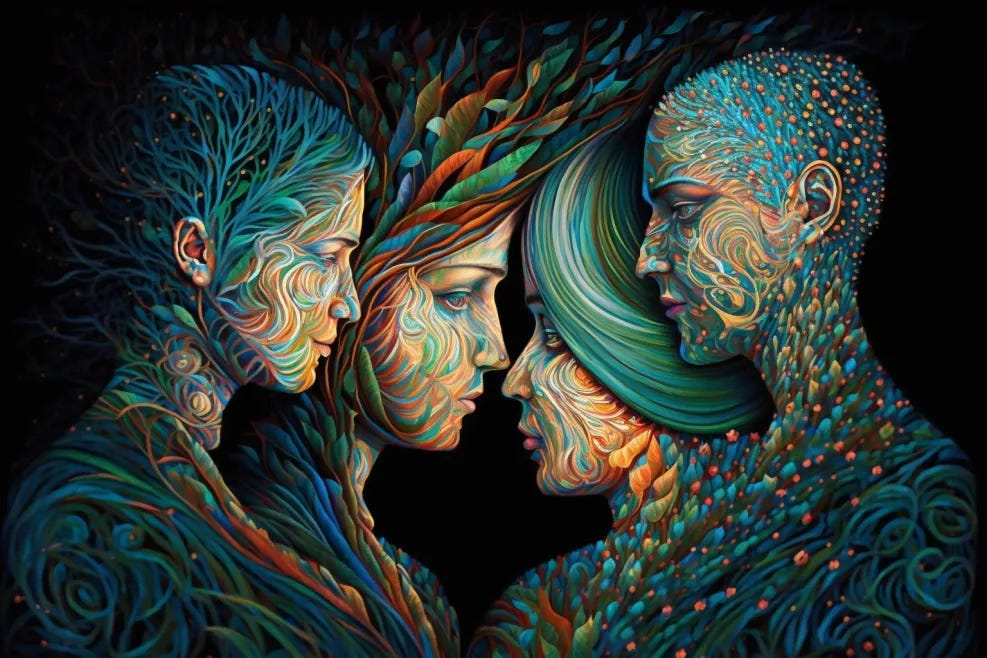
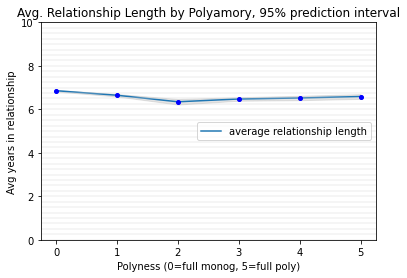






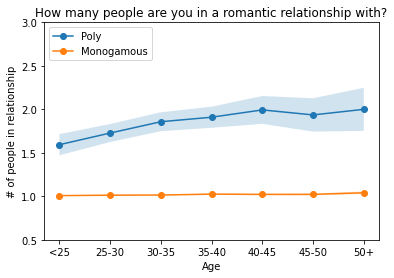






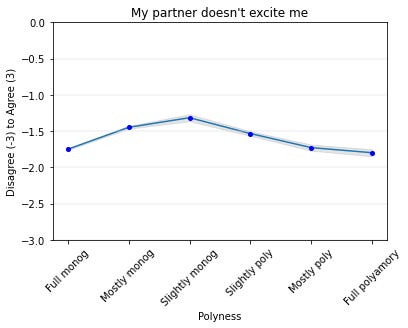




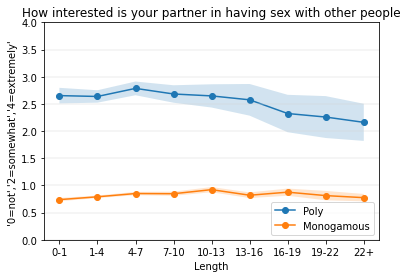





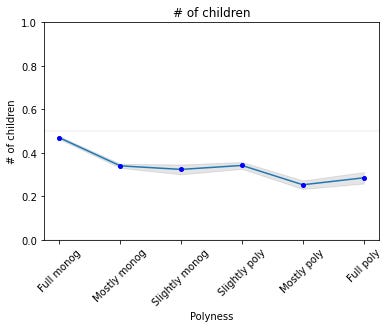





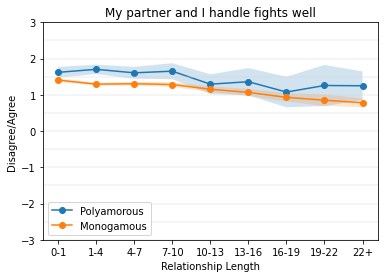
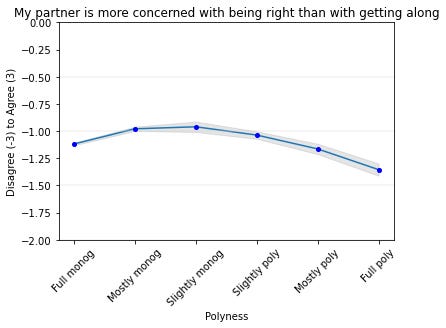

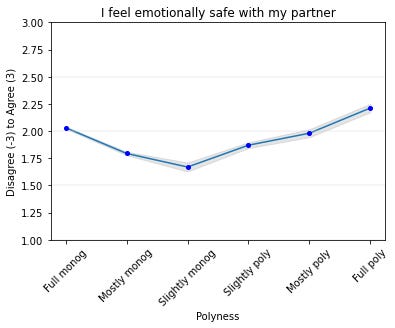





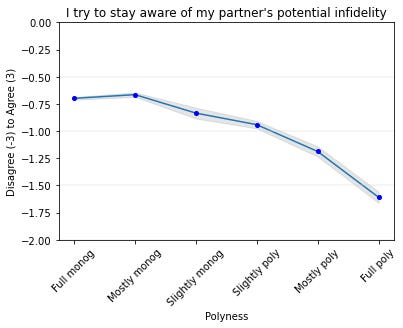









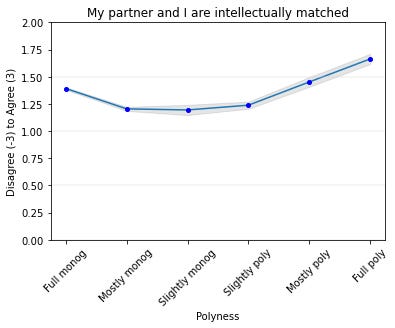









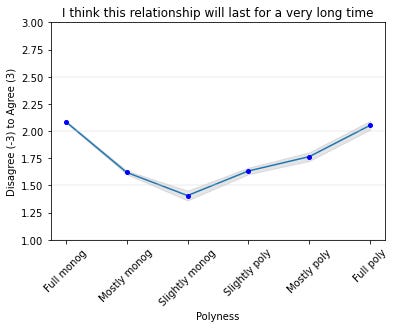





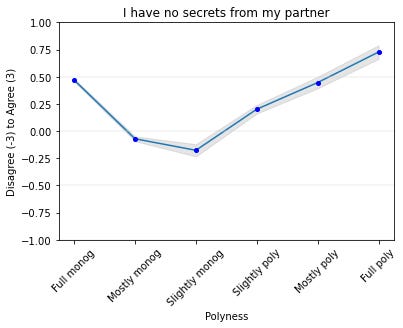













Fantastic survey and love to see the results, thank you.
I took it, and I was one of those people in the middle of spectrum stuck "sucking a bag of dicks" -- i.e. I'm at the bottom of the u-shaped curve on most of these results. It's easy to explain. FWIW I'm a cis married female in my 40s.
I answered in the middle because I would absolutely *love* to sleep with other people, but I sure as hell DON'T want my husband to. I imagine most of us in that middle area are the same.
Or, like me, we're people who tried cheating or being polyamorous in the past and the shit blew up in our faces so spectacularly that we just resigned ourselves to being monogamous even though it's somewhat painful.
In other words, it's a trade-off and there is simply no way we will ever be satisfied, without risking a lot. I absolutely want other partners. But not so bad I'm going to risk screwing up my life or losing my partner. So instead I'll just fantasize and dream about it. That of course necessarily means I am less open on that topic, because he doesn't want to hear that. I'm pretty sure he feels the same way. And I'm necessarily more ambivalent and less satisfied about the necessary trade-offs, but there's no better option. We both mutually feel we are the best possible partner the other could have, by a long shot, but that doesn't mean that only sleeping with each other the rest of our lives isn't hard and somewhat sucky. That's just reality. One that blissfully monogamous or fully poly people don't have to deal with.
One thing you did not ask about, which I would love to know, is how many people were previously in a poly relationship or attempted it, but quit and swore them off because of the dumpster fire that ensued. I know a LOT of people that applies to. In fact, it applies to everyone I know who attempted it.
For myself, I was in a poly relationship for several years around age 30 until it ended up resulting in felonies, attempted suicides, divorce, job loss, and threats of murder (not on my part but others). And I decided at that point that the potential for destructive and violent aggression when a human's sexual jealousy is provoked -- ESPECIALLY male sexual jealousy -- is not even remotely worth messing around with. It is a very powerful, dangerous, and unpredictable force. I know many others who went through the same thing with trying it and then giving up when it resulted in massive chaos and destruction -- and I am talking about people who thought it was the best thing ever at one point.
It looks like people who can be successfully poly for the long term have it made. Cheers to them. And I realize that monogamy also has a pretty good track record of resulting in divorce, suicide, and chaos. But usually that's when one or both partners fail to abide by the rules, not when they're both following them. My ex went off the deep end and permanently messed up his life even though we all played by the poly rules.
Anyway, you hypothesized here about people in mid-life giving up on monogamy and becoming poly, but I would guess that it is the other way around. Most have given up on trying to be poly by then, because it blew up in their faces. The ones who remain are really unusually good at it.
Also, on your question about the weird bump in sexual activity between ages 40 and 50: I think I know why. Society tells you that turning 30 is a big deal and less desirable after that. Everyone aged 29 is terrified, then it comes and goes and it was a big lie. Your 30s are awesome. But it's around 45-50 that reality rears its head. Things are sagging, heads are balding, body parts are not working as well as they used to. The prospect of even displaying your naked body to a new lover becomes increasingly daunting. And there's a biological impulse that kicks in that tells you "use it or lose it, NOW." I have seen many, many long married people that age, otherwise quite happy, who go on a rather intense swinging or cheating or simply lecherous phase that ramps up when your biology is screaming at you that it's your last chance and no one is ever going to want to bang you again in 3, 2, 1... So I think that's what explains that. People suddenly want to get all their shagging in while they still have options.
Last, I honestly don't see why the answers of anyone under age 25, or really under age 30, are relevant in the slightest. I get they're a big part of your sample, but you might as well throw their answers in the trash. People are SO naive and hopeful at that point, and it's easy to hack it in a relationship for a few years, anyone can do it, who cares. The vast majority of people in that age range will not be with the same partner by age 40. Many will have radically changed their views based on their experiences. It would be interesting information for a follow up in a decade to see what has changed, but at a point in time, the "relationship style" of a 23 year old is worthless.
If you had asked me at age 30 what I thought of polyamory, I would have said it was amazing the best and monogamy is for suckers and sheep. By 35, I wouldn't have touched a poly situation with a ten foot pole. It took years for me to recover the financial and life losses I incurred by messing around with it and thinking I could overcome primal instincts with enlightened behavior.
Anyway, great study and keep it up. This is the kind of thing I have always wished I could do. "They should do a study" is the most often-used phrase out of my mouth.
About the 20-year spike, I think I know what's going on. It's empty nest syndrome. People who have been together 20-25 years probably eneded up having children together, and those children while living at home may have engendered a statistically significant bias toward monogamy in their parents. Then, when they leave the home, their parents who would have otherwise been open to being open start being open. This hypothesis might also explain the bump in non-monogamy at above 45 years of age.